The best pannier racks and pannier bags for bikes 2023: sturdy and high-volume options put to the test
Bike panniers are a great option to carry luggage if you're going touring or using your bike for commuting


The best bike panniers will let you carry your luggage in comfort. But the first time you ride a bike with a rack and loaded panniers fitted, the sensation is somewhat alien. When full, panniers can add a substantial amount of weight to the bike and make any side-to-side rocking feel odd. You quickly get used to the added weight, although climbing out of the saddle may feel awkward; that's why the best touring bikes tend to have low gearing for climbs.

If you're carrying a heavy load, then placing the weight on your bike can certainly save your shoulders and back from undue stress – and you won't get the sweaty triangle associated with a backpack. Panniers can place the load lower down and may attach it more securely to your bike than even the best bikepacking bags, making for a more stable ride.
Pannier racks and panniers are popular among commuters, touring cyclists and anyone who needs to carry a substantial volume – they're great for day-to-day tasks like food shopping too.
Panniers are usually fitted to the rear of the bike, but if you've got a lot to carry - maybe on your touring bike - then front panniers are an option too.
Pannier bags need to sit on pannier racks – and thus setting yourself up is a story of two halves. Here are our picks of the best pannier racks and best panniers, both front and rear. Scroll down to the end of the page for our buyer's guide to how to choose the best bike luggage.
Best rear racks

1. Ortlieb Quick Rack
Our expert review:
Specifications
Reasons to buy
Reasons to avoid
Ortlieb's Quick Rack is a revelation where racks are concerned. Not only is the initial installation exceptionally simple, it can be removed, or remounted, in less than 20 seconds.
It's suitable for 26” and 28” (limited suitability for 29” wheels – up to max. 2.35” tyre width). Extra accessories include mudguards and adaptors for bikes that don't have eyelets.
If you only have one bike the Quick Rack enables you to quickly transform it from a road warrior to a tourer, commuter or shopper at the drop of a hat. This makes transportation a breeze too. The hooks that remain on the bike when the rack is removed are hardly noticeable.
With two hanging levels, it comfortably accommodates panniers and a rack bag at the same time without one interfering with the other.
The rack looks tidy on the bike and is well-made, encouragingly it comes with Ortlieb's 5 year warranty. While it might be more expensive than the likes of Blackburn and Topeak, our tester deemed its convenience and versatility well-worth the extra expense.
Read more: Ortlieb Quick Rack review

Specifications
Reasons to buy
Reasons to avoid
LifeLine's Alloy Rear Pannier Rack is an aluminium option for those looking to keep their costs down. With an RRP of just $33.99 / £22.99 and a maximum load of 25kg, it's one of the more affordable options.
Affordability doesn't guarantee quality though. When moving the bike rack from bike to bike while testing, we noted deterioration of the bolts. This is perhaps a rack you'll want to fit once and leave on the bike to avoid rounding the bolt heads, or maybe source better quality bolts.
LifeLine claim that the rack fits 'all wheel sizes from 26" to 700c'. We didn't agree; the arms lacked length to achieve a horizontal position on a few of our bikes.
There are eyelets for mounting reflectors and lights, though compatibility may pose issues here; we couldn't find anything to fit. The spring-loaded luggage bar is a nice addition and works well.
Overall, the Lifeline bike rack is an affordable, functional option if you know that you won't be moving it from bike to bike. If you think that it'll be swapped at some point, it might be worth investing in some better quality fixings.
Read more: LifeLine Alloy Rear Pannier Rack review

Specifications
Reasons to buy
Reasons to avoid
Topeak's Uni Super Tourist is an aluminium bike rack with stainless steel fittings. It's designed to 'fit most 24” to 29” wheel MTB and 700C touring bikes with disc brakes'. Out of the racks we tested, this one came out on top where compatibility was concerned; it fitted all the bikes that we tried it on.
The quality of construction and finishing is impressive. Unlike both LifeLine's and Decathlon's, the finish remained unmarked despite plenty of bike panniers being used on it.
With an RRP of $68.99 / £44.99, we'd say that this is definitely a value-for-money rack that should stand the test of time.
The maximum load of 26kg makes the bike rack ideal for anyone reliant on their bike for heavy shopping loads, keen tourers or those wanting a sleek system to carry a trunk bag; it features an MTX QuickTrack® plate which is compatible with any Topeak MTX TrunkBag or MTX rear basket.
Read more: Topeak Uni Super Tourist Rack review
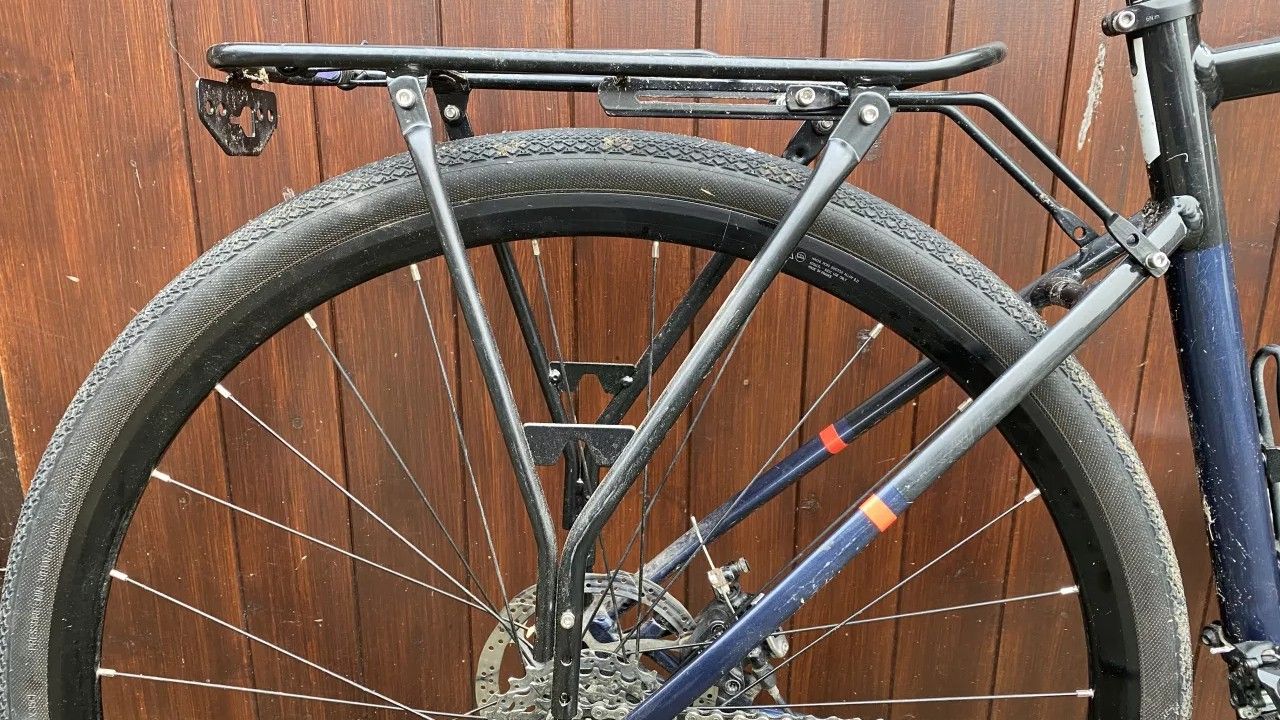
Specifications
Reasons to buy
Reasons to avoid
The Decathlon ELOPS 100 bike rack is probably the cheapest option on the market. But just like LifeLine's bike rack, affordability doesn't always deliver compatibility, or quality.
The rack is a combination of aluminium and steel with a rather delicate finish. It would be advisable to use some insulating tape at pannier contact points if you want to prolong the aesthetical appearance of the rack.
The biggest drawback of this bike rack is its flatpack status. You'll need to be a little patient and happy to fettle if you are going to mount it yourself. On the plus side, all the tools you need are supplied.
We found compatibility to be on a par with the LifeLine Alloy Rack; it certainly doesn't fit 'all 24" to 28" bikes with frames equipped with inserts'.
The 10kg weight limit makes this a good choice for anyone wanting to carry light loads.
Read more: Decathlon ELOPS 100 Bike Pannier Rack review
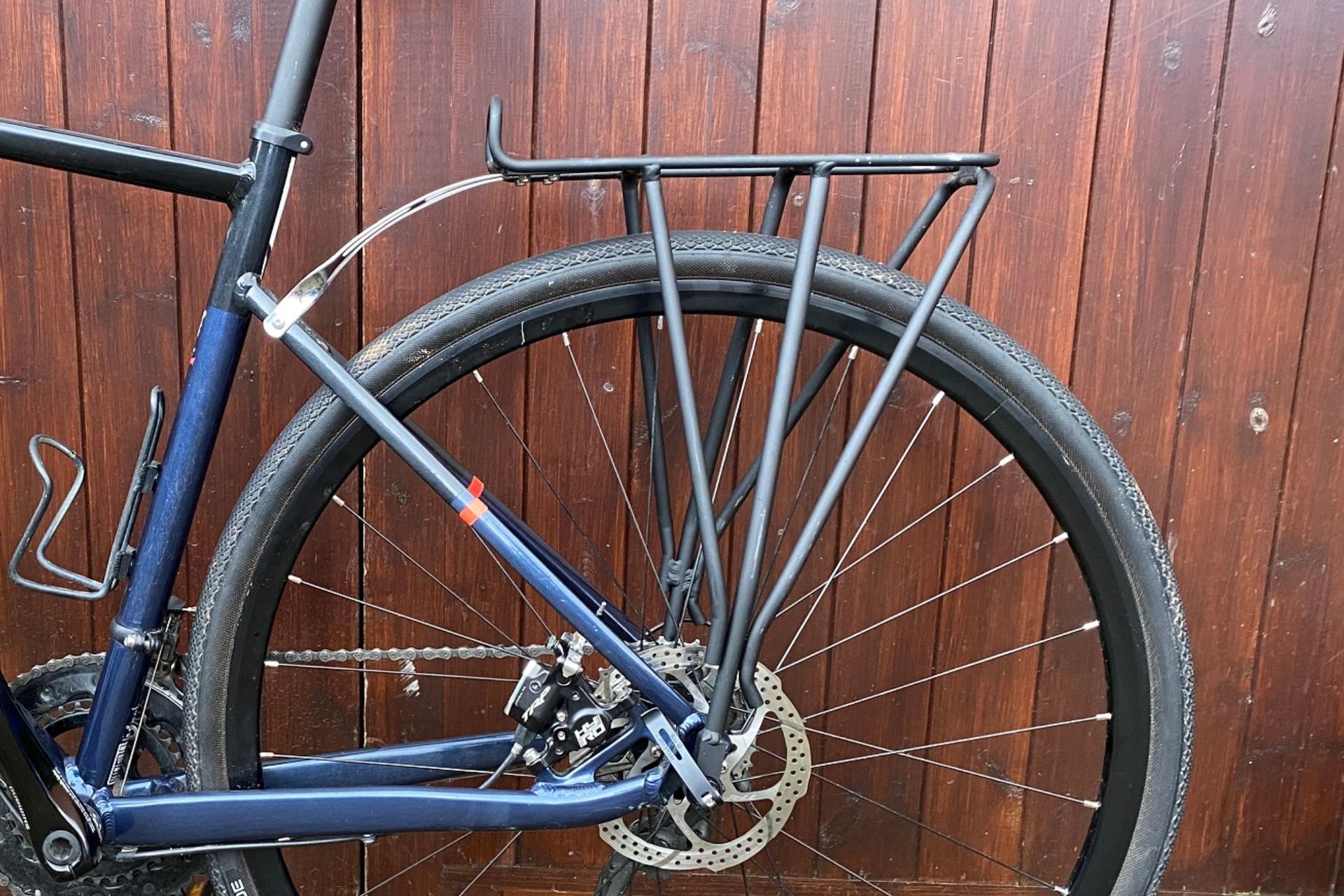
Specifications
Reasons to buy
Reasons to avoid
The Expedition 1 Rear Rack is Blackburn's legacy product. Designed by Jim Blackburn in 1975, it's made from aircraft-grade aluminium, specifically for 700c or 29er wheels, but should suit most bike wheel sizes with 9mm QR axles. As the name suggests, this is a disc brake compatible bike rack, but there is also a standard rim brake version too.
It's hard not to love the simple mounting that the supplied quick-release skewer offers. It means that you can fit the rack to a bike that doesn't have mounting eyelets. Two different sizes of P-clips are also included for attaching the arms to the frame. If you swap bikes and have mounting points, it can be directly mounted to the frame too.
This is certainly a bike rack to invest in if you have a disc-brake bike and are reluctant to fettle with a rack that claims to 'fit-all'. The Expedition 1 will likely fit the vast majority of QR, disc-brake bikes with 700C wheels.
In addition to its simple mounting and reliability, it's well-made and comes with a lifetime warranty.
Read more: Blackburn Expedition 1 bike rack review
Best rear pannier bags
Once you've got your rack sorted, it's time to choose a pannier, or two, to attach to it.
When comparing prices, be sure to check whether you are getting a pair or a single pannier; many manufacturers sell single panniers, while others only sell pairs.
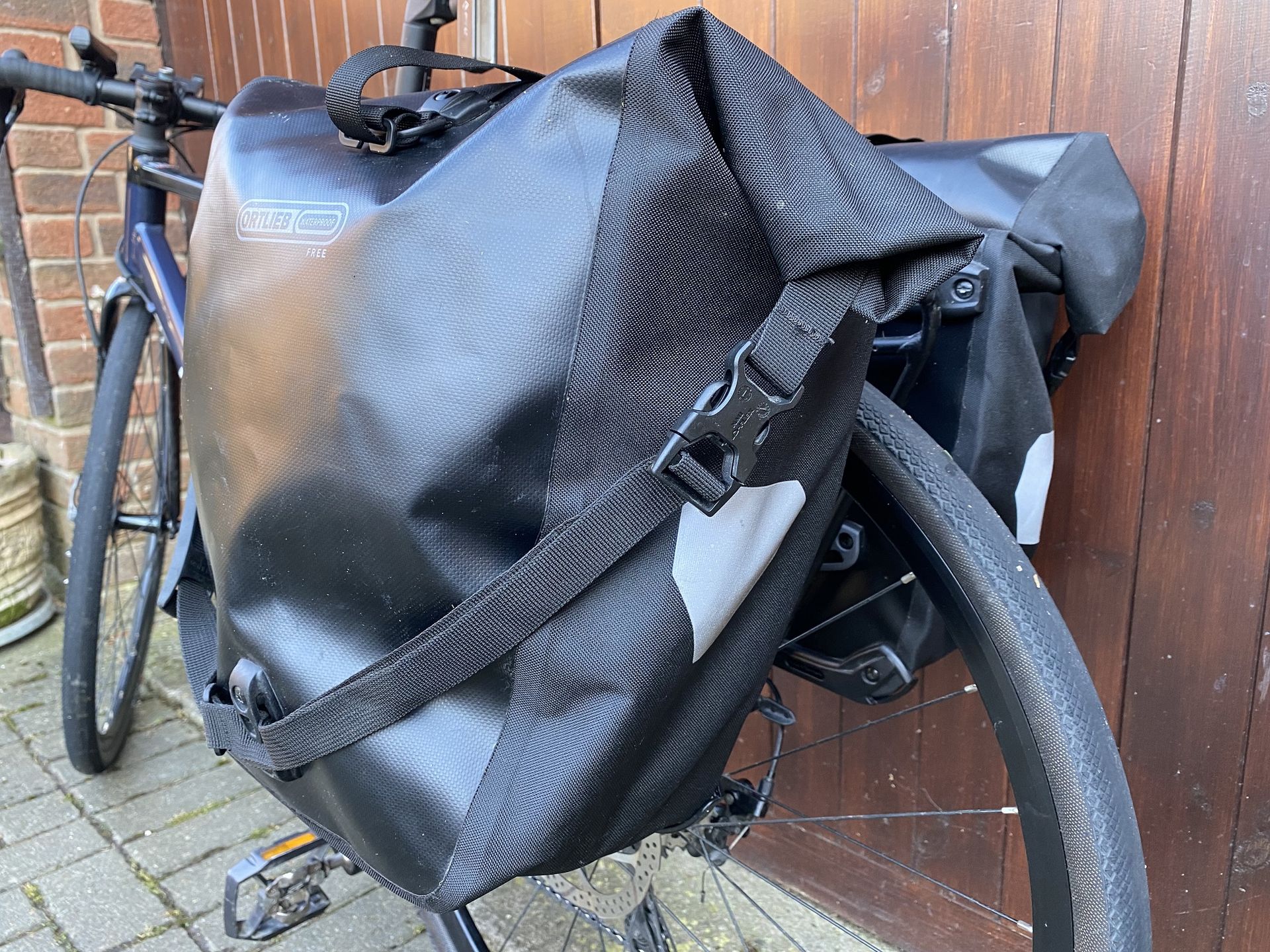
Specifications
Reasons to buy
Reasons to avoid
Ortlieb's Back Roller panniers are the choice of tourers worldwide for good reasons. The Back Roller Free boasts every feature that the long-standing Classic features: the Quick-Lock2.1 system that attaches to any pannier, tool-free adjustment, interior pouches, shoulder straps and an IP64 rating. So what's different? The latest Back Roller comes from Ortlieb's PVC-free line of products and is made of a polyurethane-coated polyester fabric.
Our tester felt that the fabric was slightly more malleable than that used on the Classic, and perhaps more vulnerable to abrasions. However, the overall performance was impressive and certainly wasn't affected by any scuffs. Indeed, the more malleable material made packing out the pannier easier.
LIke many of Ortlieb's products, these are built to last and also come with a 5 year warranty. This makes the initial $210 / £140 for a pair investment perfectly palatable.
Read more: Ortlieb Back Roller Free pannier review
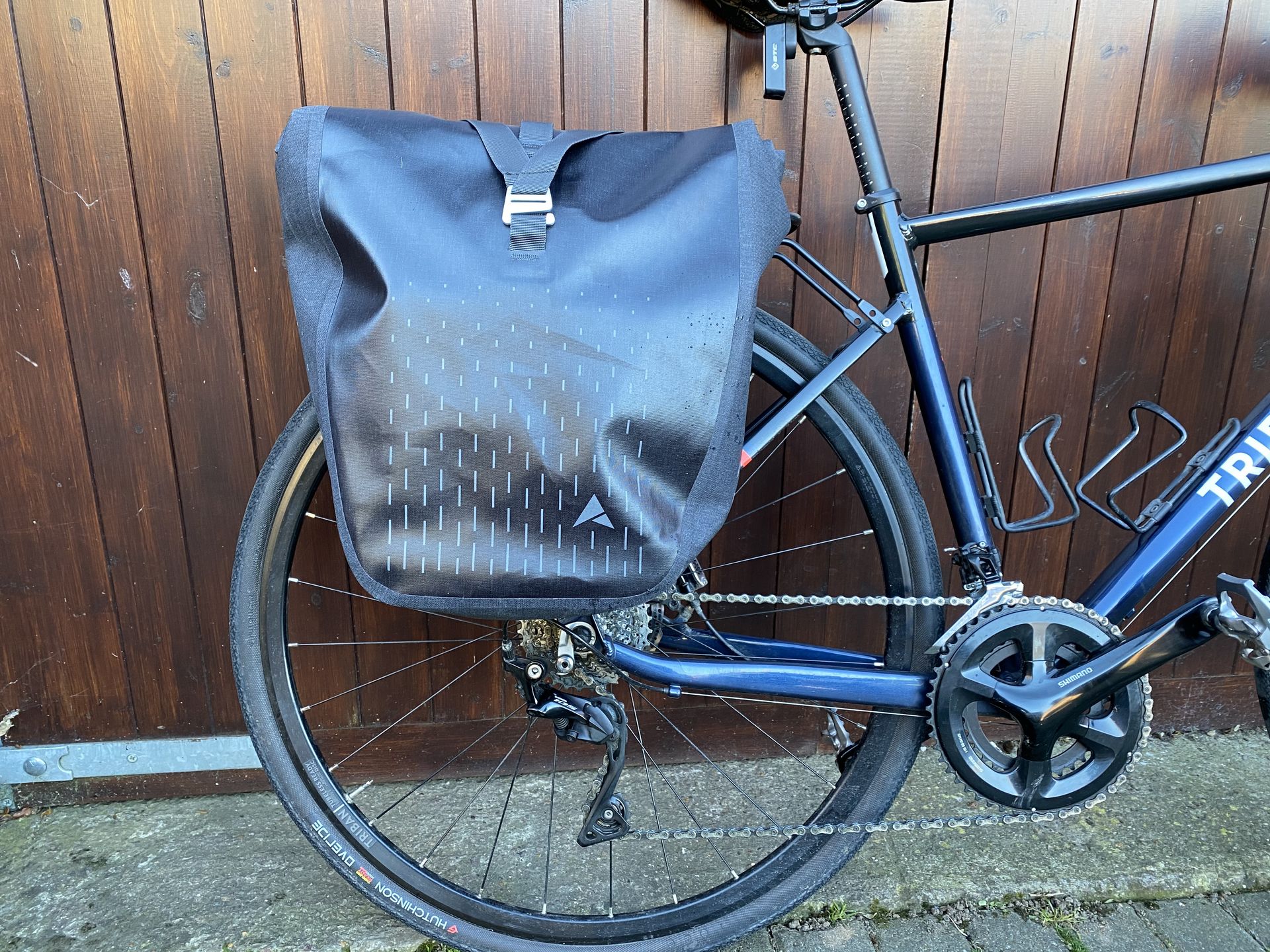
Specifications
Reasons to buy
Reasons to avoid
Altura is known for making practical kit that stands out at night; the Thunderstorm City Pannier is no exception. Its quality impressed hugely, rivalling other manufacturers for construction and waterproofing.
The roll-top closure with a single clasp is really easy to use, making the pannier ideal for anyone wanting regular, quick access to the pannier.
Reflective detailing is very good; those undertaking dark commutes will stand out in traffic.
Inside, there are two ‘open’ pouches and a zipped one, plus a key loop, while light padding protects anything in the pouches.
There's a single carry handle that is comfortable enough, though quite small. There's no supplied shoulder strap.
Given its durable, robust nature, the Thunderstorm City 20 shouldn't be confined to commuting duties; it would make for a decent touring pannier too, providing you are not trying to be too stealth.
Read more: Altura Thunderstorm City 20 Pannier review
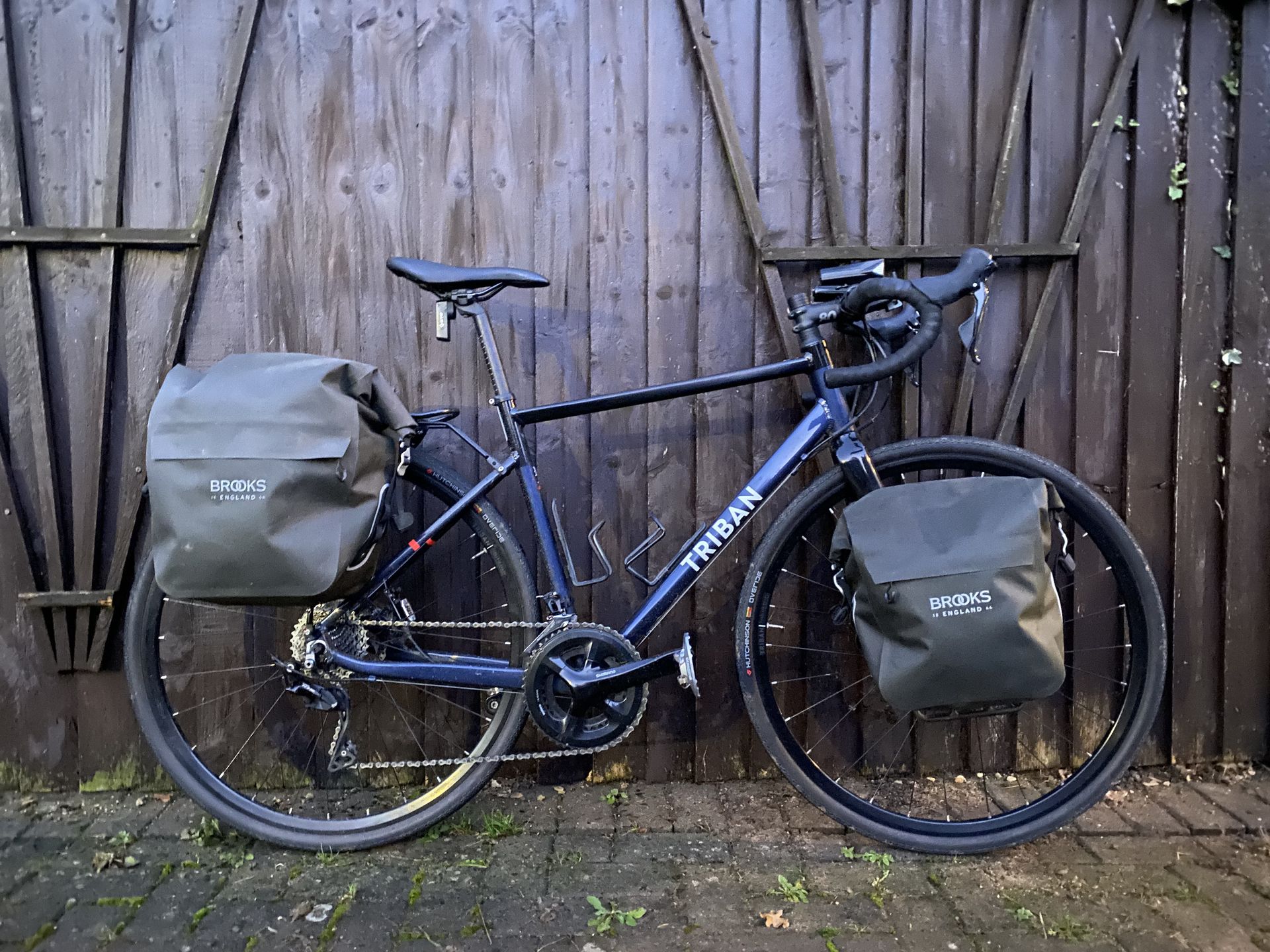
Specifications
Reasons to buy
Reasons to avoid
Brooks' Scape range features a small and a large pannier. They tick the usual boxes that you would expect from Brooks: well-made, stylish and durable.
While the range is primarily targeted at adventure riders, the Scape Panniers won't be out of place on a commuting bike, or on the rack of someone simply doing errands.
There are no interior pockets but a sizeable, watertight exterior one goes some way to make up for this; it's a functional addition that many 100% waterproof panniers don't boast.
The carry handle is not designed for comfort; it's not much more than a piece of cord. There's no supplied shoulder strap, something to bear in mind if you considering investing.
The aesthetics are certainly subtle and stylish, with just a very small amount of reflective detailing on the sides.
These may be versatile but some commuters might consider the lack of carrying options and minimal reflectives a sticking point.
Read more: Brooks Scape pannier review
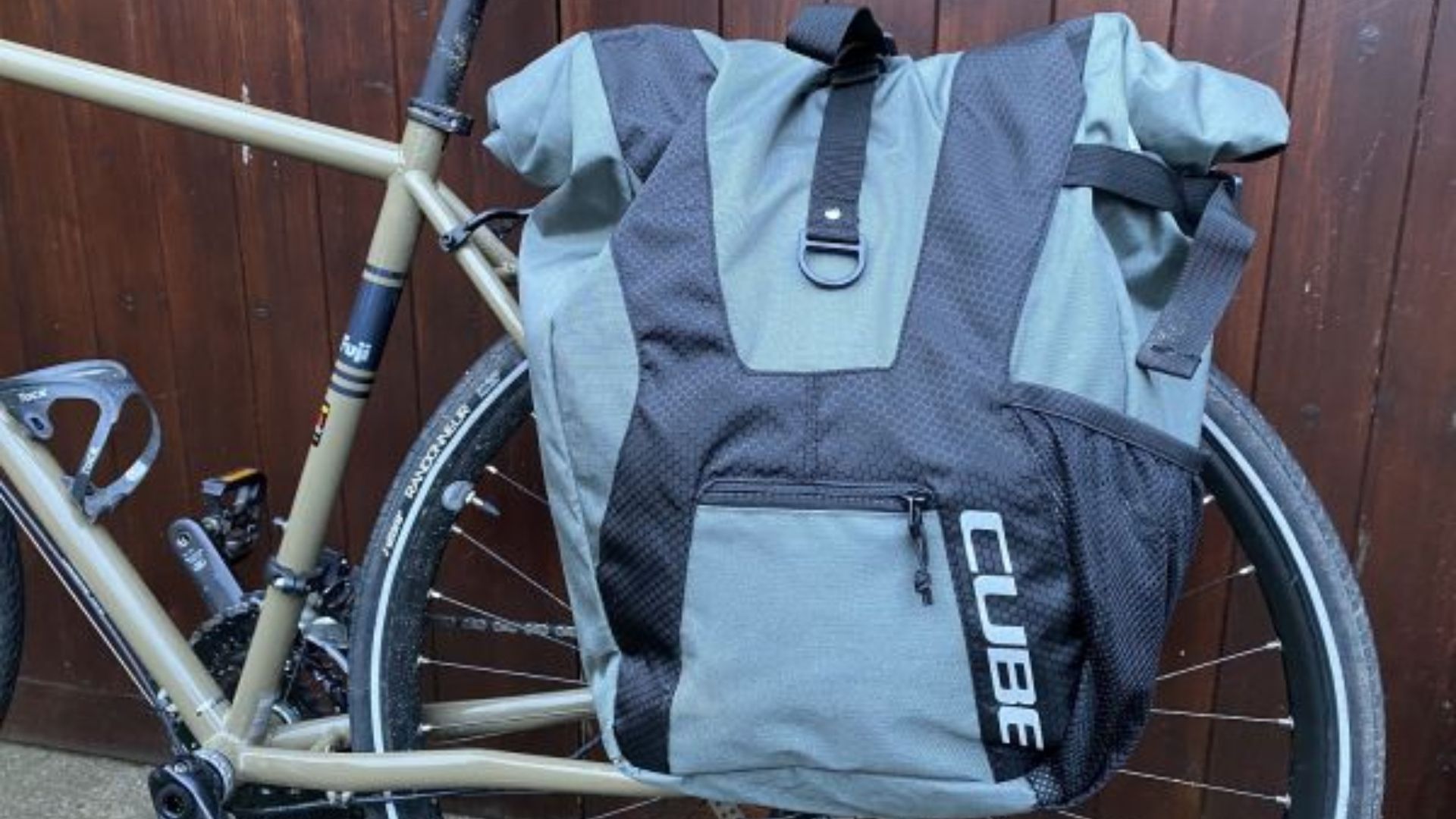
Specifications
Reasons to buy
Reasons to avoid
The Cube Travel Panniers are the only ones we tested that are sold as a pair. They are certainly best suited to commuters and those relying on a bike more than a car.
We wouldn't recommend them for touring any distance in uncertain weather conditions. While they are well made, they don't offer the waterproofing of Altura's or Brooks's. A water resistant shell comes with each pannier. It does a good job of fending off light rain, while increasing visibility. Anything heavier penetrates it.
We loved the pockets and pouches, both inside and out, though would have liked the outer zipped pocket to be a little larger.
Shoulder straps are included for both panniers and chunky buckles make these easy to use with gloved and/or cold hands.
They are roomy and well-shaped for anyone carrying bulky kit to the gym, workplace or back from the shops.
Read more: Cube Travel panniers review

Specifications
Reasons to buy
Reasons to avoid
Chrome prides itself on made-to-last kit for urban cyclists; the Urban Ex 2 Pannier is typical of the quality, robustness and style that it offers.
It's not as spacious as some, so be sure it offers the room you want before investing. Interior pockets and pouches offer excellent protection for electronic devices; a compact office is possible there. On the outside, there is daisy chain webbing to attach a D-lock to.
While we didn't find an official IPX rating on the website, we can confirm that it didn't let a droplet of water get to contents while we were testing; waterproofing is as good as the best.
Carrying options impressed hugely; two different options for carrying by hand, plus a robust, detachable shoulder strap. It's designed to be carried just as comfortably and conveniently off the bike as it is on it. These practical options, in our opinion, make the pannier one of the best for urban, office-based commuters.
The price is eye-watering, but with a lifetime warranty this is a buy-once-buy-to-last option for any discerning urban rider.
Read more: Chrome Industries Urban Ex Pannier 2.0 review

Specifications
Reasons to buy
Reasons to avoid
The Topeak Drybag DX is undoubtedly a pannier for anyone with a bulky load; its stated 25l capacity belies its seemingly bottomless form.
While reinforced side panels offer great protection for contents, they are removeable should you want a more pliable bag. It's 100% waterproof and seriously well-made.
We missed internal pockets and a shoulder strap but found the carry handle much more comfortable than something like Brooks'.
You may need to place the Drybag DX further back on your rack than other panniers; its depth could cause heel-striking.
Two colour options should satiate everyone; bright yellow for those wanting to stand out and black for those happy to blend in.
This is a single pannier purchase and we'd say be careful; fully loading it may make you feel a little unbalanced if you opt for just the one.
Read more: Topeak Pannier Drybag DX full review
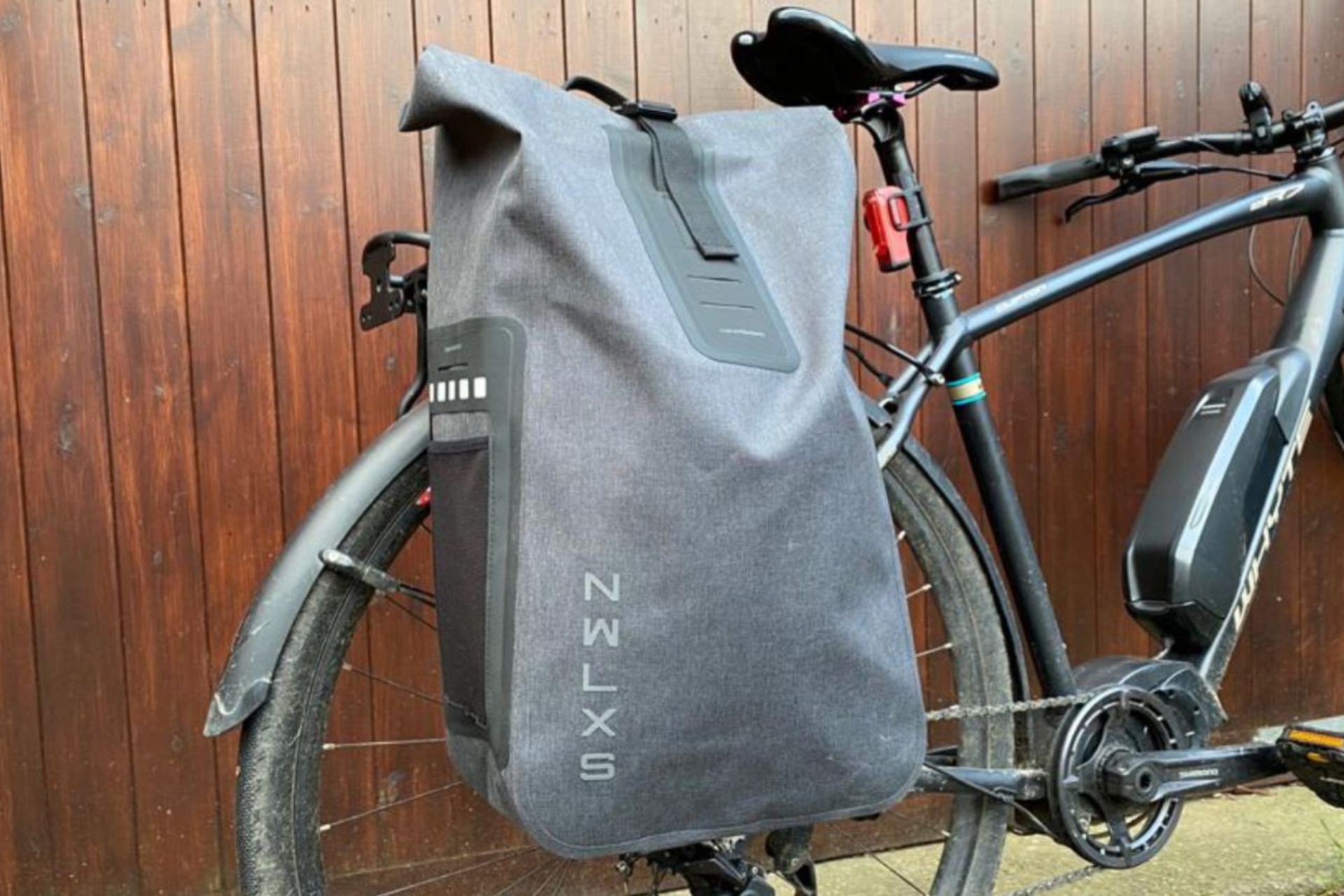
Specifications
Reasons to buy
Reasons to avoid
If you are commited to commuting and errand riding in dry weather, the New Loox Varo Backpack could be worth considering. It's a well-made piece of kit that offers decent capacity, thoughtful internal storage and is comfy as a rucksack.
The lower Velcro strap (for securing the pannier to a rack) is a little fiddly and the Railtime clamp system isn't as easy to use as some quick release panniers. Securing shoulder straps (if they aren't detached) is necessary while riding too. All of these are niggles but not major issues. Overall functionality is good with quick access, external pockets, reflective detailing and a detachable neoprene laptop sleeve.
Our tester felt that the Varo Backpack wasn't a great option for rainy weather, though; it's 100% waterproof but no one wants to put a damp and dirty pannier on their back. Stowing the shoulder straps in the pannier while riding and carrying a cloth to clean the rear is an option if you happen to venture out in the rain.
Read more: New Loox Varo Backpack full review

17. Ortlieb Fork Pack
Our expert review:
Specifications
Reasons to buy
Reasons to avoid
This is an ever-growing variety of bikepacking bags which utilize the triple-fork bosses which are becoming ubiquitous on gravel bikes of almost all stripes. To some extent, this range of options means that there are very many ways of just not quite getting it quite right. But on the other hand, it means there are fork packs out there which are really very nicely designed - and Ortlieb’s offering is one of those.
Where other brands (such as Apidura and Tailfin) go for taller and skinnier designs on their fork packs, Ortlieb has gone shorter and wider. This means that the bags do protrude a little more and don’t follow the slim lines of the fork legs quite so nicely. But it does mean that it’s much easier getting your stuff in and out with the helpfully wide entrance to the bag.
The mounting system is also excellent. If you have a triple mount fork, it’s as simple as screwing on the backing mount and then clipping on the bags. Some other brands use a more generalist cargo cargo and rely on straps for the attachment, but those can be quite a bit of a faff - especially when you have to adjust them every time you put something bulky in or out of the bag.
Ortlieb’s quick release attachment means that it’s easy to take things in and out of the bags - and it’s also easy to take the bag with you into the tent or a cafe, as it takes just a second to unclip. The bags are held on firmly and the roll top also rolls really quite far down, so you can still cinch things down pretty good when the bag is mostly empty.
The price is cheaper than quite a few of the alternatives out there - especially when you factor in the cost of a cargo cage for designs which require one. But there are also cheaper options. Still, the straightforward simplicity and effectiveness of this design makes it one of the best options out there.

18. North St. Adventure Micro Pannier
Our expert review:
Specifications
Reasons to buy
Reasons to avoid
These are neat little panniers, but there are a few features that they’re lacking. Despite that, there’s still a few good reasons to consider them - let’s jump in.
First, the good: their size is a really good balance between capacity and weight. They are much lighter than a full sized pannier, but the 14L capacity is still a really good volume for bikepacking or commuting. The front zip, internal divider and roll top all make organizing your things and accessing them really easy. They attach with velcro straps, which is convenient and the fabric has proved robust and durable too.
The downside is that they do rattle more than other systems which have some form of clipfast or cam lever attachment. Tailfin has 10L mini panniers which are particularly good for this and are a little cheaper. Which is really the next point, that these panniers are really quite expensive for how comparatively basic the design is. Altura has pannier bags that are much cheaper with about the same level of features.
But on the other hand, the North St bags are made with recycled materials, have a lifetime warranty and are made in Portland, Oregon. If you’re after something simple and rugged - and you're happy to spend a little more on manufacturing in the US - then these are a great option.
Buyer's guide to bike panniers and racks
Will my bike fit a bike rack?
Firstly, not all bikes are designed to have pannier racks fitted with ease – so you'll need to ensure your bike is suitable before you go and buy a rack. A compatible bike will have eyelets for panniers near the tops of the seatstays and sometimes specific rack mount eyes next to the mudguard eyes above the rear dropouts.
If your bike doesn't have eyelets, you can buy mounting systems which attach directly to the frame and rear axle. Here it's important to pay attention to if the rack is or isn't compatible with your braking system, e.g disc brakes.
You can even buy seat post clamps with integrated bosses. Alternatively, there are loads of frame and saddle bags available now which are ideal for lighter-weight tourers and bikepacking. They have the advantage of not needing specific mounting points on your bike (although top tube feed bags may be designed to mount on the bosses that are a feature of many of the best gravel bikes).
Assuming you have a bike set up for a rack, or you know you can get a mounting system, it's time to choose a rack.
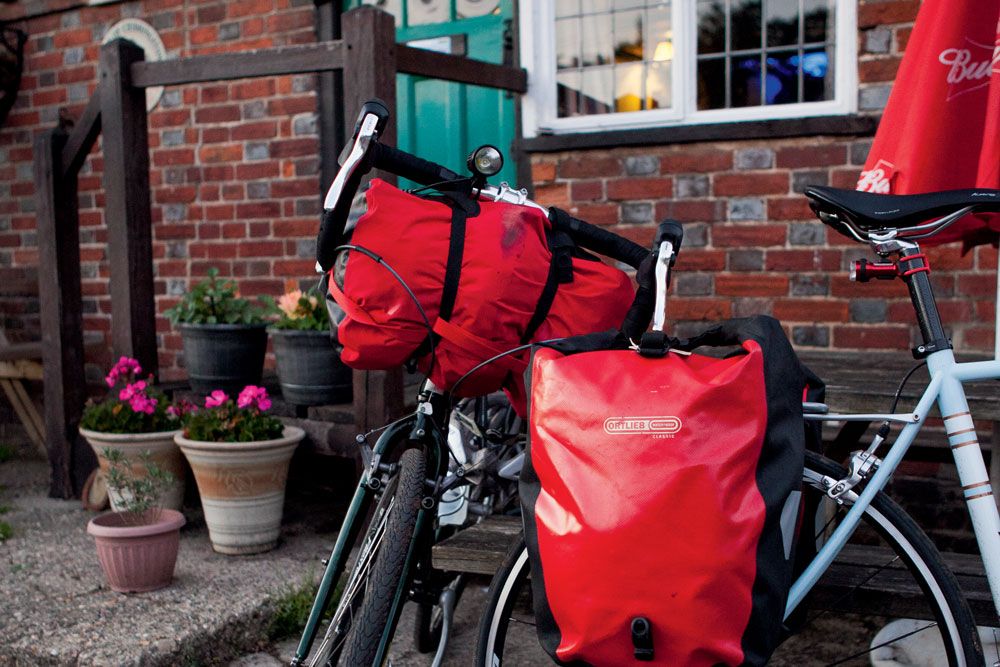
Do I need a front or a rear rack and panniers?
The most common style of pannier rack is fitted to the rear of the bike – but you can also opt for a rack at the front too. If you're carrying a moderate load it's probably easier to go with the rear.
If you're taking a lot of kit, opting for both and distributing it so that the greatest weight is at the back but there's some at the front will improve handling. It also makes the bike easier to push around and carry and less front-light if the rear is loaded so that the weight is close to or aft of the rear wheel.
Just having a front rack and panniers may affect your bike's steering, so should be avoided.
What are pannier racks made of?
Pannier racks are typically made from steel, aluminium or titanium. Aluminium is generally cheapest, and it's perfectly adequate. Steel is the strongest, though it can rust over time – unless you opt for stainless steel. Titanium is lightweight and it doesn't corrode – but it's more expensive.
What else should I look for?
The maximum weight that a pannier rack can withstand is a pretty crucial stat, so check this before buying.
Some bike racks offer more heel clearance than others. Purpose-designed touring bikes usually have long chainstays designed with panniers in mind, but if you're using a classic road bike with shorter chainstays (or your feet are on the larger side) then it's worth opting for one with more space allowance.
Many brands also supply add on mounting kits that help create a better fit with your bike – providing more heel clearance, adjusting the height at which the rack fits to offer a more natural centre of gravity, or with an extended mounting system to cater for pesky disc brakes.
One thing to be aware of is that while many racks will claim to fit 'all bikes' with specific wheel sizes, the ever evolving geometry of bike frames often means that they don't. The three we had on test recently certainly didn't 'fit all'.
What should I look for in the best bike panniers?
Your choice of pannier will be heavily influenced by intended use: durability, waterproofing, maximum weight/capacity and personal style all come into the equation.
Ortlieb is pretty much the market leader. The German-based manufacturer creates highly durable, totally waterproof panniers, with roll tops that keep the moisture out.
For those carrying a lighter load, there are plenty of panniers which can be removed from the bike and used as a standard backpack or shoulder bag, useful for shoppers and commuters.
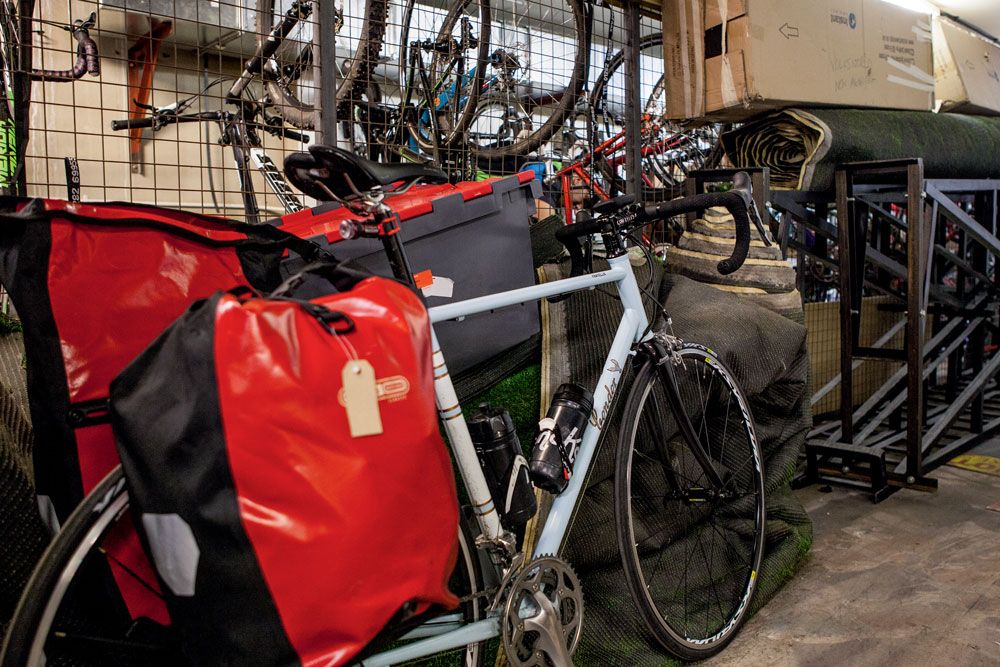
Where should I ride?
If you are looking for where to ride tour, check out our top eight places to ride in the UK or head off the beaten track with an adventure road or gravel bike ride tour.
Also check out our guide to absolutely everything you need to go bikepacking. Much of the list is the same for the well-prepared bike tourer.
Get The Leadout Newsletter
The latest race content, interviews, features, reviews and expert buying guides, direct to your inbox!
Michelle Arthurs-Brennan the Editor of Cycling Weekly website. An NCTJ qualified traditional journalist by trade, Michelle began her career working for local newspapers. She's worked within the cycling industry since 2012, and joined the Cycling Weekly team in 2017, having previously been Editor at Total Women's Cycling. Prior to welcoming her daughter in 2022, Michelle raced on the road, track, and in time trials, and still rides as much as she can - albeit a fair proportion indoors, for now.
-
 Rohan Dennis charged with causing death by dangerous driving following death of wife Melissa Hoskins - reports
Rohan Dennis charged with causing death by dangerous driving following death of wife Melissa Hoskins - reportsHoskins, the two-time Olympian, was killed in a car crash on Saturday
By Adam Becket Published
-
 GripGrab Women’s Windbuster Windproof Lightweight Vest review - minimalist design executed well
GripGrab Women’s Windbuster Windproof Lightweight Vest review - minimalist design executed wellA two-zipper and a mesh rear panel really help aid temperature regulation and work excellently with the front windshield
By Anna Marie Abram Published

